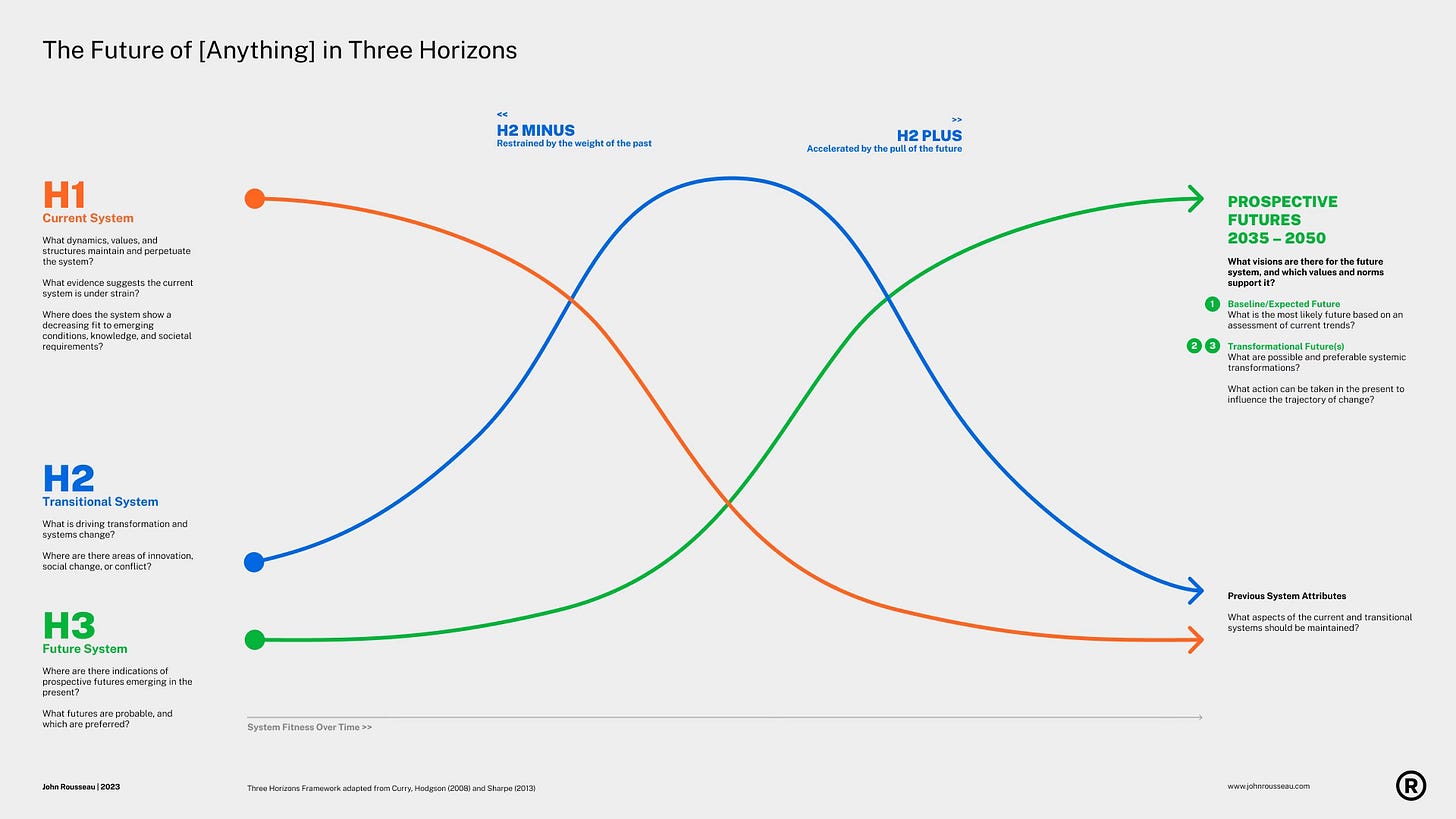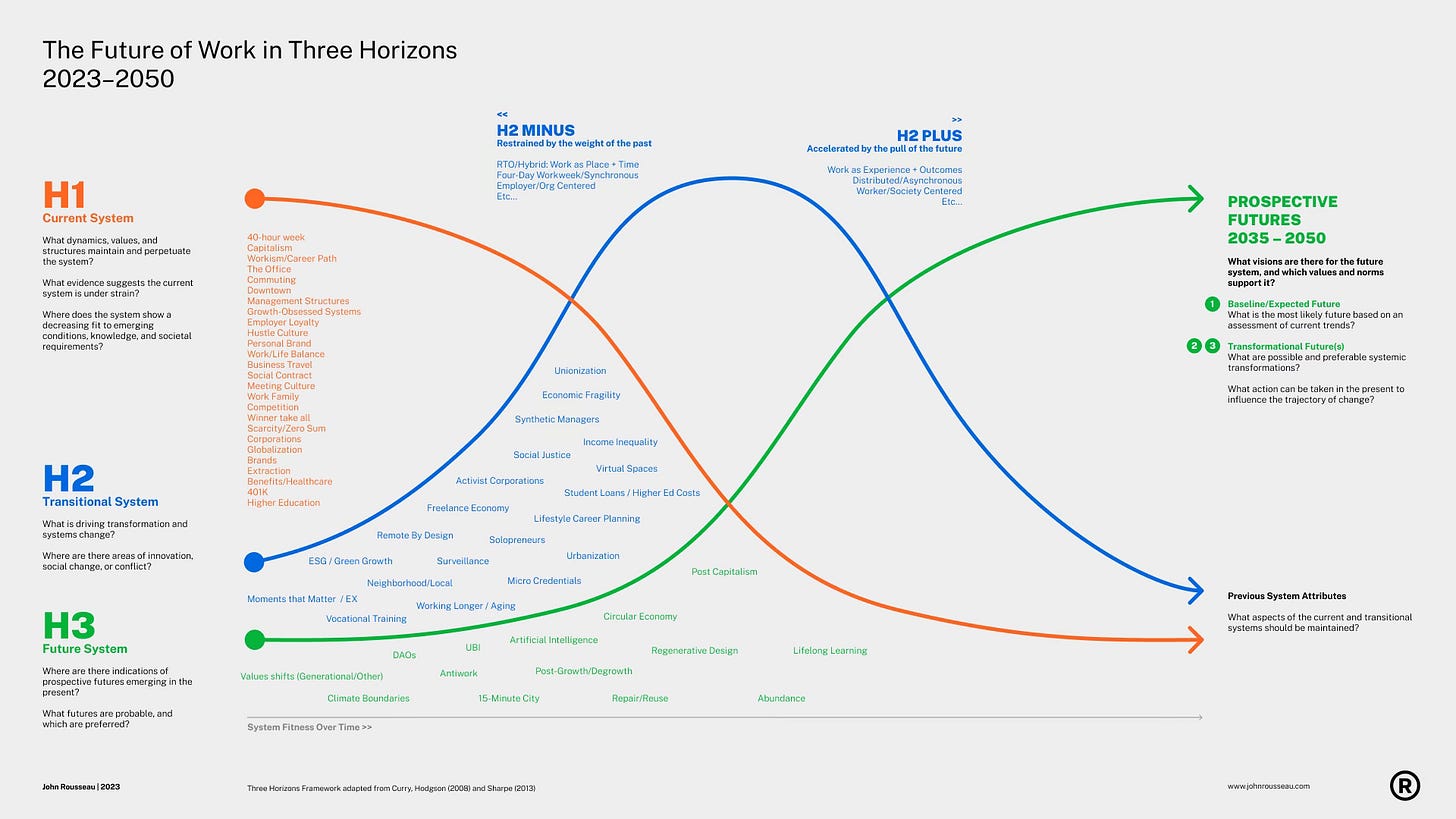The Future of Work in Three Horizons
Opening new possibilities for collaborative sense-making, strategic design, and human agency in the future of work
Prelude
What do you think of when you think of the future of work?
How did you get there—to that idea?
Did you consider…
What signals of change are visible in the present?
What is already happening?
Where is the current system breaking down?
What would you most like to preserve about the ways things are?
What would you most like to transform?
Where is there agency and leverage to influence change?
Now zoom out.
What is the purpose of work?
How does work relate to other complex systems, like mobility, education, the economy, and the environment?
What assumptions are being made?
What values and worldviews are evident? How are those changing?
Where are there conflicts? Trade-offs?
Who or what has power? How might that change?
What is the expected future?
Are other futures possible?
Which future is preferable? How might it come about?
What pathways of change are available?
What actions can we take in the present?
Reframing the Future of Work
Reflecting on the current discourse there are two dominant narratives in circulation. First, the question of where and how work ought to happen, and second, the emergence of artificial intelligence. The first narrative aims to reverse the current trajectory of change, while the other assumes the inevitability of change that has not yet occurred.
Both views are limiting when it comes to making strategic choices and taking action in the present. This is partly because a myopic perspective is blind to broader system dynamics, and even more because thinking this way lacks critical imagination about what could be.
What could be?
A coherent vision of the future…
That considers all stakeholders.
That is systems literate.
That recognizes and amplifies agency.
That leads to action.
That is open to learning.
That is resilient by design.
How might that look?
Three Horizons
Three Horizons is a foresight and sense-making method designed to help groups externalize observations and assumptions about present and future system dynamics, identify and understand signals of change, explore possible futures, align on a shared vision, and identify potential actions to influence change in the present. It is applicable to any complex domain and works equally well as the basis of a half-day workshop or the foundation of a more rigorous analysis.
The framework comprises three “horizons” of change:
Horizon 1 (H1) refers to the current (dominant) system, which is under stress due to entropy as strategic fit with the environment declines
Horizon 2 (H2) refers to the transitional system, as innovations and conflict either revitalize the dominant system or act as pathways for transformation
Horizon 3 (H3) refers to the emergence a new system, which in turn becomes the dominant system while fit-for-purpose aspects of previous systems remain in play
Each of the horizons can be observed in the present moment and from a specific vantage point. In a collaborative setting, the typical order of operations is to first map the H1 context, then move to H3 (signals of change in present, possible and preferred futures), and then H2 (what slows/accelerates change). I prefer to outline potential futures and align on a vision last, after discussing system dynamics across all three horizons and as part of a more holistic process—so that the process is informed by deep learning and iteration before and after a workshop.
The three curves are a conceptual representation of reality; the model is based on a specific theory of change and is designed to prompt explicit perspective taking, dialog, and analysis, but should not be taken literally. Likewise, the placement of specific trends and changes during a working session is not intended to be location-specific.
Let’s look at the future of work in Three Horizons.
This is a rough sketch that reflects my own perspective apart from any specific organizational or industry context, based on futures research and environmental scanning over the past 12-18 months (roughly “post COVID”). It is not exhaustive. The visualization and description has been simplified for purposes of the example—there are many more system dynamics, concepts, and signals of change that could be added (ideally as part of a co-creative process).
H1: The Current System
Here you will see a list of present-day orthodoxies—the structures, dynamics, and values that comprise the current world of work. Some have already lost their fitness for purpose and are being rethought (e.g., the office, commuting), some are in clear decline (e.g., the social contract), while others remain dominant (e.g., economic growth, capitalism). In a collaborative setting, it would be worthwhile to gather perspectives from diverse stakeholders, noting areas of agreement and disagreement and the reasons why. In most cases, there are aspects of the current system that create value and should be maintained. This is also worth discussing, along with the underlying values and assumptions that inform various points of view.
H3: The Future System
H3 is more speculative—a set of emerging dynamics in the present that could have profound implications for the future of work. Many of these are direct challenges to the dominant system. This includes the cluster of changes related to sustainability and economics (e.g., post-growth, regenerative design), technology (e.g., AI, automation), and society (e.g., values shifts regarding the meaning and purpose of work, consumerism, and evolution of the social contract). The main thing is to see these as related shifts within an integrated system. H3 is a glimpse into what could be. What types of futures are more preferable? What are the implications of these? Where could actions in the present influence desirable change?
H2: The Transitional System
This is the liminal space between H1 and H3—a place of innovation and conflict, visible through more established patterns of change. Some of these will be evolutionary changes that are restrained by the weight of the past and reinforce aspects of the H1 system, such as the current “hybrid” workweek or the ascendant four-day workweek. These changes are referred to as “H2 Minus.” Others are accelerated by the pull of the future, such as asynchronous, remote-first organizations, or changes related to societal values shifts. These changes are referred to as “H2 Plus.” (Sharpe, 2020) Here too, there may be productive debate over classification and the underlying values and assumptions.
If you enjoyed this post, please consider a one-time donation. Thank you for supporting my independent design, writing, and research.
Implications
Looking across the three horizons, new possibilities begin to emerge. A more nuanced view of the larger system and its entanglements, along with a more open view of what work might become. What do career paths look like in 2050, as people live longer but potentially consume less? Where do people live in relation to work? Are we still measuring time? Might work be seasonal? What is the future of management? Of collaboration? What are the most meaningful use cases for artificial intelligence—and the most critical guardrails? And of course, what of the office?
By shifting the frame and adopting other perspectives, we can look at questions like these with greater clarity and creativity. We can see that where and how we work is embedded in other systems and subject to other changes. We can externalize the many assumptions we are making about AI. We can recognize our agency and envision new opportunities and pathways. And we can start designing the future of work today in terms of proactive policies and human-centered ways of working that are directed toward a shared vision of resilience and prosperity.
References
Curry, A., & Hodgson, A. (2008) Seeing in multiple horizons: Connecting futures to strategy
Searching for systems in Three Horizons. (2023). The Next Wave.
https://thenextwavefutures.wordpress.com/2023/08/20/searching-for-systems-in-three-horizons/
Sharpe, B. (2020). Three Horizons. Triarchy Press.
Three Horizons | International Futures Forum. (2012). https://www.internationalfuturesforum.com/three-horizons




Three Horizons | International Futures Forum. (2012). https://www.internationalfuturesforum.com/three-horizons
found the date, Jun 12 2012.
Really appreciate your questions in the prelude John. Use this framework a lot for individual businesses and am working on a version for the arts and cultural sector; had a few blocks and your questions helped me get unstuck :)